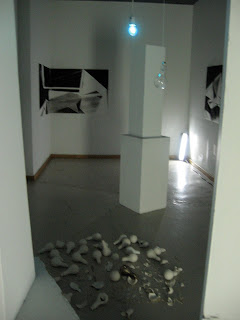The Banff Centre promotes itself as a specific and unique place in association with its epic natural context. Since January when I arrived to work at the Centre I have been continuously debating with myself whether the setting provokes people to start considering their surroundings as a source of inspiration for artistic production or whether it’s simply a secluded environment in which to harness one’s focus (regardless of the Rocky Mountains, the wildlife, the lakes and rivers).
Although many people (artists, tourists, restaurant workers etc.) come to the town of Banff in order to have ready access to nature, there’s still quite a few of us who are here only for the Centre and the international cultural aspects. Like myself, to which skiing and hiking are not selling points, my relationship to the identity of Banff as closely approximated to its natural environment doesn’t feel, well, natural to me. I see it as an artificially constructed identity to a large degree. My ideas about how people are inspired by nature and how they choose to artistically express their feelings, interactions, and experiences in nature seem already outdated only because my kind of art is about so much more than an interaction with something viscerally real and more about a mediation of experience (art that's about art). Nature is the ‘real’ in Banff, while hipster intellectualism is the ‘real’ within an urban environment. Both are silly, but undeniably influential to art practice.
After having lived in Alberta for only four months, I have noticed a marked difference in how people relate to their surroundings. In Banff, nature is always in the conversation – not a day goes by without talking about the mountains, about the strangeness of the town of Banff in relation to the Centre, animal presence etc. From living in Toronto for almost three years, I can’t recall the city itself as a main conversation topic. From Alberta I have learned more about Canada as a highly varied landscape recognizing that provincial location distinctly influences how people live.

Lessonlands, 18min, HD Black and White
Rory Middleton with sound and original score in collaboration with Andrew Dickens
Images courtesy of artist.

Lessonlands, Rory Middleton
The footage in this video comes from areas along the coast of Scotland which he has been editing and compiling while he’s been in Banff. With expectations that all nature images I would see coming out of the Centre would be dealing with the Rockies, snow and elk sightings, there were surprisingly no mountains and frozen lakes presented to me in this video. Within the isolated Banff bubble, knowing that people often come here to work with its locational specifics, I was reminded that different representations of nature exist and that it cannot be considered as one all encompassing theme – instead it informs us of the distinct differentiations of place and context.

Jonathan Green, Polaris Lost, The Other Gallery, The Banff Centre, 17-19 May 2010
Installation images courtesy of artist.
An installation in The Other Gallery, Polaris Lost (May 17-19th) by Jonathan Green, a Studio Work-Study from St. John’s, NFLD who’s been working at the Centre almost one year, involved interpretations of a rather epic and dramatic 1871 expedition into the Arctic on the ship Polaris. Several high contrast charcoal drawings, which depict some amazing combinations of starkness and busy variations in mark making, filled the wall space. These were accompanied with a variety of elements: fluorescent lights propped in corners, a mast-like pole precariously propped with lines of twine, stacked plinths positioned too close together, and porcelain casts of lightbulbs crushed in one area of the floor beneath some vintage blue lightbulbs. All these elements combined to evoke specific interpretations of an environmental experience which just so happens to be a distinct identity separate from Banff.

Polaris Lost, The Other Gallery
After living in a few different Canadian cities, context has often revealed itself as somehow not as important if only because I am always myself; the identity I bring with me is my own context which never changes – my problems follow me, people follow me (physically and non-physically). Living in Banff has made me realise how much my context actually affects my personality and how I live my life – unsure of how to identify the variable, me or my context at any given time - we can assume that both are effected, potentially right along with my art practice.